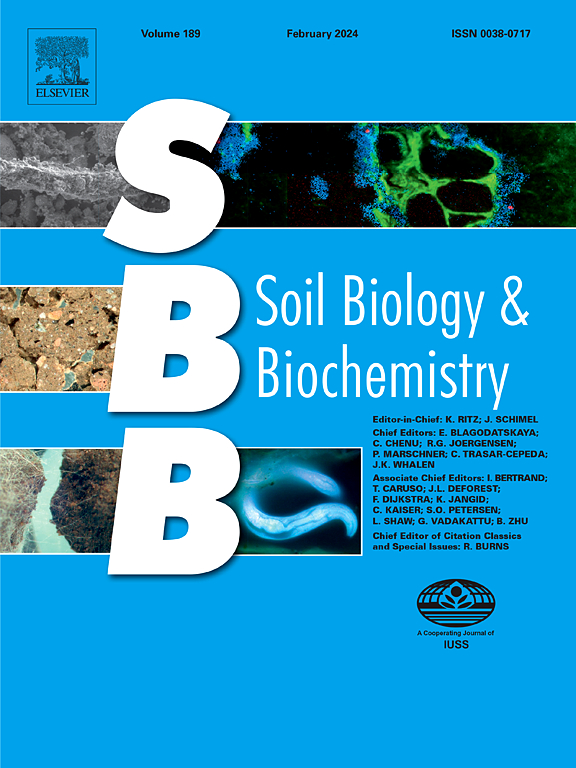Contribution of microbial necromass to soil organic carbon in profile depths exhibited opposite patterns across ecosystems: A global meta-analysis
IF 10.3
1区 农林科学
Q1 SOIL SCIENCE
引用次数: 0
Abstract
Microbial necromass carbon (MNC) is a crucial component of soil organic carbon (SOC) and plays a significant role in long-term carbon sequestration. However, the distribution patterns of MNC across soil profiles remain poorly understood. Here, we compiled a dataset of 1447 observations from depths of up to 1 m across cropland, forest, and grassland ecosystems to evaluate the distribution and key influencing factors of MNC. MNC content consistently decreased from 9.3 g kg−1 in topsoil (0–20 cm) to 2.4 g kg−1 in deep soil (60–100 cm), regardless of ecosystem types. Fungal necromass contributed more to SOC in topsoil, whereas bacterial necromass dominated deeper soil profiles. The MNC/SOC ratio decreased from 50.9 % in topsoil to 34.2 % in deep soil for croplands. In contrast, the MNC/SOC ratio increased from 26.2 % in topsoil to 44.2 % in deep soil for forestland and increased from 39.7 % in the topsoil to 52.2 % in the subsoil (40–60 cm) for grassland. Cropland topsoil exhibited a low proportion of large macroaggregates, which were negatively correlated with the MNC/SOC ratio and microbial quotient. This suggests possible destabilization of plant-derived carbon due to intensified microbial activity from macroaggregate disruption. The microbial necromass accumulation coefficient (MNC/microbial biomass C) decreased with soil depth in croplands but increased in forests and grasslands. Nitrogen availability and clay content were the primary regulators of the MNC/SOC ratio in cropland topsoil, whereas the C/N ratio was the dominant controlling factor in forests and grasslands. These results suggest that the MNC/SOC ratio in cropland topsoil is associated with rapid microbial turnover due to high nitrogen availability, coupled with MNC stabilization promoted by high clay content. Overall, our results indicated that MNC/SOC ratio was more important in deep soil than in topsoil and showed an opposite pattern in cropland. This highlights a potential strategy for enhancing SOC in croplands by promoting the stabilization of plant-derived carbon through macroaggregate formation.
微生物坏死块对剖面深度土壤有机碳的贡献在不同生态系统中表现出相反的模式:一项全球荟萃分析
微生物坏死体碳(MNC)是土壤有机碳(SOC)的重要组成部分,在长期固碳中起着重要作用。然而,跨国公司在土壤剖面上的分布模式仍然知之甚少。在此基础上,作者收集了1447个耕地、森林和草地生态系统深度达1 m的观测数据,以评估跨国公司的分布及其关键影响因素。无论生态系统类型如何,表层土壤(0-20 cm)的MNC含量均从9.3 g kg - 1下降至深层土壤(60-100 cm)的2.4 g kg - 1。表层土壤中真菌坏死团对有机碳的贡献更大,而深层土壤中细菌坏死团的贡献更大。表层土壤MNC/SOC比值由50.9%下降至34.2%。林地表层土壤的MNC/SOC由表层土壤的26.2%增加到深层土壤的44.2%,草地表层土壤(40 ~ 60 cm)的MNC/SOC由表层土壤的39.7%增加到下层土壤的52.2%。农田表层土壤大团聚体的比例较低,与有机质/有机碳比和微生物商呈负相关。这表明植物源碳的不稳定可能是由于微生物活动加剧造成的大团聚体破坏。农田土壤微生物坏死块积累系数(MNC/微生物生物量C)随土壤深度的增加而降低,森林和草地土壤微生物坏死块积累系数随土壤深度的增加而增加。氮素有效性和粘粒含量是农田表层土壤有机质/有机碳比的主要调节因子,而碳氮比是森林和草地表层土壤有机质/有机碳比的主要控制因子。这些结果表明,农田表层土壤有机质/有机碳比与高氮有效性导致的微生物快速周转以及高粘土含量促进的有机质稳定有关。总体而言,研究结果表明深层土壤中MNC/SOC比表层土壤更重要,而农田中则相反。这突出了通过形成大团聚体来促进植物源碳的稳定,从而提高农田有机碳的潜在策略。
本文章由计算机程序翻译,如有差异,请以英文原文为准。
求助全文
约1分钟内获得全文
求助全文
来源期刊

Soil Biology & Biochemistry
农林科学-土壤科学
CiteScore
16.90
自引率
9.30%
发文量
312
审稿时长
49 days
期刊介绍:
Soil Biology & Biochemistry publishes original research articles of international significance focusing on biological processes in soil and their applications to soil and environmental quality. Major topics include the ecology and biochemical processes of soil organisms, their effects on the environment, and interactions with plants. The journal also welcomes state-of-the-art reviews and discussions on contemporary research in soil biology and biochemistry.
 求助内容:
求助内容: 应助结果提醒方式:
应助结果提醒方式:


